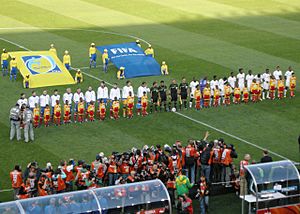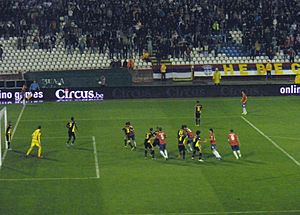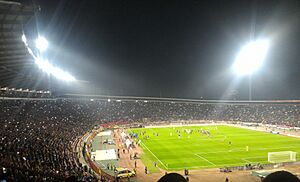History of the Serbia national football team facts for kids
The history of the Serbia national football team started way back in 1920. That's when Serbia played its very first international football game! Over the years, the team has changed names as the country itself changed. This article tells the story of Serbian football, from its early days to its most recent adventures on the world stage.
Contents
Early Days: Kingdom of Yugoslavia (1920–1941)

The first national football team was formed in the Kingdom of Serbs, Croats and Slovenes. This was a country that existed between World War I and World War II. The football association was created in Zagreb in 1919 and joined FIFA.
The team played its first international match at the Summer Olympics in Antwerp, Belgium, in 1920. They played against Czechoslovakia and lost 0–7. Even though they lost, the players made history by being the first to represent their country.
First World Cup Appearance (1930)
In 1929, the country changed its name to Yugoslavia. The football association moved its main office to Belgrade. The national team then took part in the 1930 FIFA World Cup in Uruguay. They finished in fourth place, which was a great achievement!
In their first World Cup match ever, Yugoslavia surprised everyone by beating the strong Brazil team 2–1. The team was made up of players mostly from Serbian football clubs. Players from Croatian clubs did not join because of a disagreement about the football association's move.
Socialist Yugoslavia Era (1945–1992)
After World War II, a new country called Socialist Yugoslavia was formed. Football started up again, and the national team continued to play.
Olympic Success: Silver Medals (1948 & 1952)
Yugoslavia did very well in the Olympic football tournaments. In 1948, they won against Luxembourg, Turkey, and Great Britain. They reached the final but lost to Sweden, earning a silver medal.
In 1952, with many of the same talented players, Yugoslavia again finished as runners-up. They played against the legendary Hungary team in the final. One famous match was against the Soviet Union, where Yugoslavia was leading 5–1 but the Soviet team made an amazing comeback to tie 5–5! Yugoslavia won the replay match easily.
European Championship and Olympic Gold (1960s–1980s)
Yugoslavia hosted the European Championship in Belgrade and Zagreb. The national team played in eight World Cups and four European Championships. They also won the Olympic football tournament in 1960, bringing home a gold medal! They also won three silver medals and one bronze medal at the Olympics.
Team Splits Up (1990s)
Towards the end of the Cold War, Yugoslavia started to break apart. This led to rising tensions between different parts of the country. The football team also began to feel these changes.
Before the 1990 World Cup, a friendly match in Zagreb saw some fans cheering against the Yugoslav team. As Yugoslavia broke up, the team split into different national teams. The remaining team, representing the Federal Republic of Yugoslavia (FRY), was not allowed to play in the Euro 92. This decision was made just ten days before the tournament started.
Yugoslavia had qualified for Euro 92, but because of international rules, they couldn't play. Denmark took their place and went on to win the competition! The FRY team was also not allowed to play in the qualifiers for the 1994 FIFA World Cup.
Serbia and Montenegro Era (1992–2006)
The Federal Republic of Yugoslavia was formed in 1992, made up of Serbia and Montenegro. However, its sports teams were banned from international events for a while.
First Games and World Cup Return (1994–1998)
The new national football team played its first game on December 23, 1994, a friendly match against Brazil. They lost 0–2. Three days later, they lost to Argentina. Even with two losses, it was an honor to play against such strong teams for their first matches.
Because of the international rules, the team couldn't play in the 1994 World Cup or the Euro 1996 qualifiers.
On March 31, 1995, the team got its first official win, a 1–0 friendly against Uruguay. This was also their first home game in Belgrade. Savo Milošević scored the first goal for the new team. A year later, they won their first World Cup qualifying game, beating the Faroe Islands 3–1. They later had their biggest win ever, beating the Faroe Islands 8–1.
Yugoslavia finished second in their qualifying group, behind Spain. They had to play a special play-off against Hungary. Yugoslavia won easily, 7–1 in Budapest and 5–0 in Belgrade, for a total score of 12–1. This meant they qualified for the 1998 FIFA World Cup!
Many experts thought Yugoslavia could do very well at the 1998 World Cup in France. They had many talented players. They were in a group with Germany, the United States, and Iran. Yugoslavia won their first game 1–0 against Iran. Their next game was a 2–2 draw against Germany, after leading 2–0. They then beat the United States 1–0. Germany won the group because of a better goal difference.
In the Round of 16, Yugoslavia played against the Netherlands. The Netherlands scored first, but Slobodan Komljenović equalized for Yugoslavia. Later, Yugoslavia got a penalty kick, but Predrag Mijatović hit the crossbar! This was a turning point. In the last seconds of the game, the Netherlands scored a winning goal, ending Yugoslavia's World Cup journey.
Even though they were unlucky, the team showed they were among the world's best. They were often ranked in the Top 10 in the FIFA World Rankings after the 1998 World Cup.
Euro 2000 Journey
The qualifiers for UEFA Euro 2000 were exciting because Yugoslavia was in a group with Croatia, marking their first games since the breakup of Yugoslavia. They also played against the Republic of Ireland, Macedonia, and Malta.
The team started well with wins against Ireland and Malta. A home game against Malta had to be played in Greece because of events in Yugoslavia. They still won 4–1. The first match against Croatia in Belgrade ended in a 0–0 draw. After a loss to Ireland, they beat Macedonia twice. A 2–2 draw against Croatia in their final game was enough for Yugoslavia to qualify for Euro 2000.
In the Euro 2000 finals, Yugoslavia was in a group with Spain, Norway, and Slovenia. In their first game, Slovenia took a surprising 3–0 lead, but Yugoslavia scored three goals in six minutes to draw 3–3! They then beat Norway 1–0. In their final group game against Spain, Yugoslavia led three times, but Spain scored two late goals to win 4–3. Yugoslavia still finished second in the group and moved to the next round.
In the quarter-finals, Yugoslavia again played the Netherlands. This time, the Netherlands won easily, 6–1. Savo Milošević was one of the best players for Yugoslavia in the tournament. He was the joint top scorer with five goals.
World Cup Qualifiers (2002 & 2006)
The 2002 World Cup qualifiers were tough for Yugoslavia. They failed to reach a major tournament for the first time since their return. The team faced many changes in coaches and struggled to win games. They finished third in their group and did not qualify.
For the 2006 FIFA World Cup qualifiers, the country was now called Serbia and Montenegro. The team had a fantastic qualifying campaign! They finished first in their group, ahead of strong teams like Spain, and did not lose a single game. Their defense was amazing, letting in only one goal in ten matches. This was the best defensive record of all 51 teams in the qualifiers!
The "Famous Four" defense, including players like Nemanja Vidić and Mladen Krstajić, along with goalkeeper Dragoslav Jevrić, were key to this success.
Just before the 2006 World Cup, Montenegro declared its independence from Serbia. It was decided that the Serbia and Montenegro team would still play in the World Cup, and then split into separate teams afterward.
In the 2006 World Cup group stage, Serbia and Montenegro lost their first game to the Netherlands 0–1. They then suffered a big 0–6 loss to Argentina. With two losses, they couldn't qualify for the next round. In their final game, they lost 2–3 to Ivory Coast, even after leading 2–0. It was a disappointing World Cup run.
Serbia National Team (2006–Present)
After Montenegro became independent, Serbia played its first match as an independent nation. They won 3–1 against the Czech Republic.
Euro 2008 Qualifiers
Serbia began its Euro 2008 qualifying campaign with a 1–0 win over Azerbaijan. They stayed undefeated in 2006 with four wins and two draws. However, in 2007, they lost to Kazakhstan and drew with Portugal. Serbia finished third in their group and did not qualify for Euro 2008. The team's first foreign coach, Javier Clemente, was replaced.
Golden Years and World Cup (2008–2010)
Under new coach Radomir Antić, Serbia's World Cup qualification campaign started strongly in 2008. They beat the Faroe Islands and Lithuania, and won against Austria in Vienna. They also had a big 6–1 win over Bulgaria.
In 2009, Serbia continued their great form, beating Romania away and Austria at home. A 1–1 draw with France, the 2006 World Cup runners-up, was a good result. On October 10, 2009, Serbia secured their spot at the 2010 FIFA World Cup with a huge 5–0 victory against Romania.
At the 2010 World Cup in South Africa, Serbia was in a group with Germany, Ghana, and Australia. In their first game, they lost 0–1 to Ghana after a late penalty. In their second match, Serbia had a sensational 1–0 win against Germany! This was called "the most famous day in Serbia's footballing history."
Serbia needed just one point from their last game against Australia to reach the knockout stages. However, they lost 1–2, finishing last in the group and being eliminated.
Tough Qualification Campaigns (2011–2016)
After the 2010 World Cup, Serbia faced several difficult qualification campaigns for major tournaments. For the Euro 2012 qualifiers, they started well but then had some setbacks, including a match against Italy that was stopped due to crowd trouble. They missed out on a play-off spot by just one point.
For the 2014 World Cup qualifiers, Serbia was in a tough group with Croatia and Belgium. They had some important wins but also suffered defeats. They finished third in their group and did not qualify for the World Cup. During this time, key players like Dejan Stanković and Nemanja Vidić retired from international football. Branislav Ivanović became the new captain.
The Euro 2016 qualifiers were also challenging. Serbia faced Portugal, Denmark, Albania, and Armenia. A controversial match against Albania led to points being deducted from Serbia, making qualification very difficult. Serbia finished second to last in their group and did not qualify for Euro 2016.
Return to the World Stage (2018)
Serbia started their 2018 FIFA World Cup qualification campaign with a 2–2 draw against Ireland. They then had important wins against Moldova and Austria, with Aleksandar Mitrović scoring key goals. A 1–1 draw against Wales was also a good result.
In 2017, Serbia continued their strong performance, beating Georgia and Moldova. A crucial 1–0 win against Ireland put them very close to qualifying. On October 9, 2017, Aleksandar Prijović scored the winning goal against Georgia, sending Serbia to the 2018 FIFA World Cup!
After qualifying, coach Slavoljub Muslin was replaced by Mladen Krstajić. Serbia played friendly matches against teams like China, South Korea, Morocco, Nigeria, Chile, and Bolivia, preparing for the World Cup. Mitrović even scored his first hat-trick for the national team against Bolivia.





